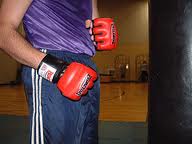 In some countries whose warriors are glorified and put on a pedestal with each successful homecoming, boxing is nothing but ordinary. The accomplishments and accolades of Muhammad Ali, Manny Pacquiao and Joe Frazier make the sport even more larger than life. Boxing rings and studios are as common as the ubiquitous basketball court, with kids engaging in friendly brawls and make believe matches.
In some countries whose warriors are glorified and put on a pedestal with each successful homecoming, boxing is nothing but ordinary. The accomplishments and accolades of Muhammad Ali, Manny Pacquiao and Joe Frazier make the sport even more larger than life. Boxing rings and studios are as common as the ubiquitous basketball court, with kids engaging in friendly brawls and make believe matches.
It is no wonder then that the fitness world will follow its lead with an answer to the craze with kickboxing. Although it has been around for decades, never has the sport been more popular – or more influential – than this time.
Kickboxing traces its origins from Japan. Created by Japanese boxing promoter Osamu Noguchi and called Kikkubokushingu in Japanese, kickboxing is mainly a group of martial arts and combat sports based on kicking and punching and derived from Muay Thai, Karate, and Boxing. It has a broad and colorful history, with elements of its source also coming from Europe and North America. It is often practiced for self defense and fitness and has contributed to the surfacing and development of mixed martial arts that most people are so into these days.
Kickboxing is so diverse it can be interpreted in a narrow or wide sense. In its narrow sense, its style is limited only from Japanese or American kickboxing or has rules based from shoot boxing or K-1. In its wider sense however, it includes styles from all stand up combat sports such as Savate, Muay Thai, Indian boxing, Burmese boxing, Sanshou, and other styles of karate and combat sports.
As a workout, kickboxing becomes a great cardiovascular exercise. It has similar goals of building strength, increased metabolism, and has a bonus of teaching you some self-defense techniques which might come in handy at any given time. A well suited workout routine is most beneficial as it takes everything at face value into consideration before you step into the program. It is also an interesting and fun workout to both men and women, with classes being typically held with people sweating by the bucket while enjoying the pace, aside from the 500 to 800 calories burned per hour – a good indicator of one’s commitment and staying power in an exercise regimen.
 Kickboxing has four basic punches which are the jabs (quick strikes with the dominant hand landing on the opponent’s face), hooks (arc shaped punch of the dominant hand landing on the opponent’s cheek or temple), crosses (similar to jabs but delivered by the rear hand), and uppercuts (thrown by the rear hand traveling upward towards the chin). Its basic kicks are the front kick and the side kick, with the roundhouse kick being an advanced kickboxing maneuver.
Kickboxing has four basic punches which are the jabs (quick strikes with the dominant hand landing on the opponent’s face), hooks (arc shaped punch of the dominant hand landing on the opponent’s cheek or temple), crosses (similar to jabs but delivered by the rear hand), and uppercuts (thrown by the rear hand traveling upward towards the chin). Its basic kicks are the front kick and the side kick, with the roundhouse kick being an advanced kickboxing maneuver.
There are three different forms of intensity to the cardio kickboxing workout. These are low impact, moderate impact and high impact. The low impact intensity is a great way to enhance your flexibility and form, while the intensity of the high impact workout significantly strengthens the heart and contributes to weight loss. After just a couple of weeks into the routine, one is most likely to build endurance and stamina and encounter a significant improvement in speed, power and agility.
As kickboxing tends to burn calories and exhaust muscles, it is necessary to alter your diet to keep up with your body’s relatively new energy needs. An increase in calorie and protein intake is necessary, along with proper hydration to replace lost fluids through excessive sweating during the workout – a small price to pay for an intense and rewarding workout such as kickboxing. Staying fit and having fun at the same time never looked so appealing.


